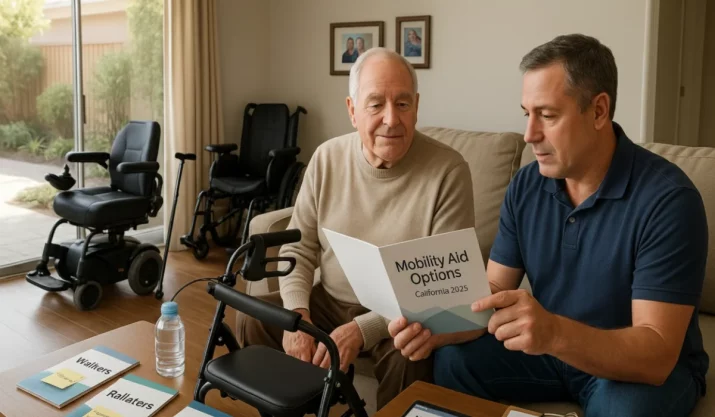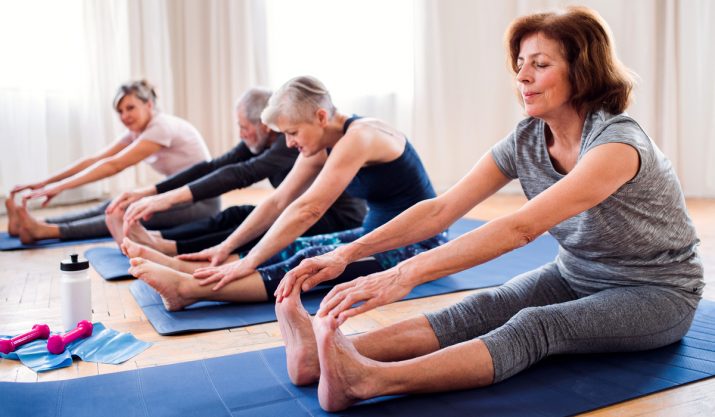How to Choose the Right Mobility Aid for Everyday Activities

Table of Contents
Mobility challenges do not take away your independence. The right mobility aid helps you stay independent, safe, and confident in daily life. There are many devices, from rollators to power wheelchairs, so that the choice can feel overwhelming.
In California, seniors and families weigh options for aging in place—your lifestyle, support needs, and home layout guide the device you choose. The right mobility aid does more than help you move. It supports a better quality of life and keeps you active in your community.
This guide explains each type of mobility aid, its role in daily life, and what to consider before making a choice.
Key Takeaways
- To choose the right mobility aid, match it to your lifestyle and mobility level. A good fit boosts safety, comfort, and independence at home and in the community.
- Canes, walkers, and rollators help with balance issues or mild difficulty walking. For long distances or outdoor use, rollators and scooters are ideal.
- Power wheelchairs are suitable for individuals with limited mobility or low upper-body strength. They turn well in tight spaces and provide steady mobility assistance all day.
- Consult with a physical therapist to select the most suitable assistive device. They can also explain Medicare, insurance options, and safe use.
Understanding Different Types of Mobility Aids
It is helpful to know the main types of mobility aids and how each one fits into daily life. Your choice depends on balance, strength, and where you need support, indoors or outdoors.
Walking Aids for Balance and Stability
Walking aids are a first step for balance problems or mild walking limitations. Quad canes have a four-point base for extra stability. They help on uneven ground and can support more body weight.
Standard walkers are very stable, but you must lift them with each step, which can tire the arms and shoulders. Rollators often feature a seat, allowing you to stop and rest during errands or outdoor trips.
Scooters and Power Wheelchairs for Longer Distances
For greater mobility, scooters and power wheelchairs offer increased independence. Scooters are helpful if you can walk short distances but need assistance on longer trips, such as at malls or parks. They reduce fatigue from long walks, and many users value them for their ease of use.
Power wheelchairs utilize a joystick and turn easily in tight spaces, such as apartments, kitchens, and hallways. They work well for all-day use and provide reliable support over an extended period.
Manual Wheelchairs for Short-Term or Flexible Use
Manual wheelchairs are reliable and budget-friendly if you have good upper-body strength. Doctors often recommend them for short-term recovery after surgery or part-time use. Lightweight, foldable models are easy to lift into a car or take on public transit. These models help caregivers who load or store the chair between outings.
Matching Devices to Daily Life
Each mobility device has a role. Walking aids are suitable for individuals with mild balance or walking limitations. Scooters and power wheelchairs support bigger limits, indoors and outdoors. Manual chairs offer a portable option if you can self-propel.
By understanding how each type of mobility aid functions, you can identify which option aligns with your lifestyle, level of support, and long-term goals. This knowledge enables you to select the senior mobility solution that best suits your needs.
Matching Mobility Aids to Your Daily Activities
Choose a mobility aid that fits your daily routine. The correct device should make shopping, social events, and moving at home easier. Examine your habits and surroundings to choose a safe and comfortable option.
Outings and Social Activities
If you shop often, attend services, or meet friends, rollators and scooters add stability and ease. Rollators combine support with a built-in seat, allowing you to rest on longer outings. Mobility scooters make longer trips more comfortable and reduce fatigue in large spaces, such as malls or parks.
Home and Apartment Living
Where you live also matters. In small apartments or narrow halls, a power wheelchair turns well. Many models have a tight turning radius, which is particularly helpful in areas such as kitchens, bathrooms, and bedrooms. If you plan to split your time between indoors and outdoors, choose a model designed for both environments.
Mobility Level and Strength
Consider your mobility level and upper-body strength. If your arms and core are strong, a manual wheelchair can be a suitable option, especially for short-term or occasional use.
If you have mobility issues or tend to get tired on long walks, a power wheelchair or scooter may be a better fit. A physical therapist can check your balance, strength, and lower-body stability to recommend the best option.
Role of Caregivers
Due to their learning, caregivers’ skills can often assist with transfers, adjustments, and transportation. Select a device that suits the user’s needs and is practical for the caregiver to use. Lightweight, foldable designs are easier to lift and store.
Powered devices can reduce strain on caregivers during long outings. Considering both viewpoints helps you choose a safe and comfortable aid for your loved one.
Key Factors When Choosing the Right Mobility Aid
Practical details significantly impact how well a device integrates into daily life. Focus on safety, fit, comfort, and long-term use.
Weight Capacity and Adjustability
First, check the weight capacity. If you exceed the limit, the device may wear out faster or become unsafe. Adjustability also matters. A device set to your height and size offers better support and reduces strain.
Look for ergonomic handles or seating that eases pressure on joints. This fit is ideal if you use the device for several hours each day.
Portability and Storage
Your home and routine determine how portable your aid should be. Foldable scooters and wheelchairs store well in small spaces and load easily into a car. For outdoor use, look for durable frames, wider wheels, and suspension to handle sidewalks, trails, and slopes.
Indoors, maneuverability matters most. A tight turning radius is particularly helpful in kitchens, halls, and bathrooms.
Cost and Insurance Coverage
Costs vary widely and may guide your choice. Medicare and some private plans may help cover the cost of walkers, scooters, and power wheelchairs when prescribed by a healthcare professional. Check your eligibility before buying to avoid unexpected costs and find an affordable option.
By considering factors such as weight capacity, fit, portability, and insurance, you can select a safe, comfortable, and practical mobility aid.
When to Consult Healthcare Professionals
Choosing among many mobility aids can feel overwhelming. Professional guidance makes the process easier. Start with a physical therapist. They can check your balance, mobility, and strength.
Based on the exam, they may suggest that it is time to use a cane, a rollator, or a power wheelchair. They can train you to use the device safely and effectively. Training from healthcare professionals helps you avoid strain, falls, and poor habits.
Healthcare professionals can determine whether your mobility limitations are short-term or long-term. If you are recovering from surgery, short-term devices like crutches or a standard walker may help until you regain strength and have fully recovered.
For long-term conditions such as arthritis, multiple sclerosis, or advanced age-related mobility issues, a power wheelchair or scooter may be a more suitable option. These devices support independence and reduce strain.
Medical specialists can also explain insurance and Medicare coverage for needed equipment. Working with your care team helps you pick a mobility aid that fits your needs, comfort, and safety.
Making the Right Mobility Aid Choice for Your Lifestyle
Selecting a mobility aid is also about planning for the future. As your needs change, the correct device can adapt with you; whether that means easier travel, simpler storage, or equipment that reduces strain on caregivers. Thinking ahead helps you stay prepared and avoid frequent replacements.
California Mobility works with individuals and families to match devices with both current and long-term needs. Our focus is on practical solutions that make daily routines smoother and safer.
Contact us today to receive personalized guidance and discover the mobility aid that suits your lifestyle.






